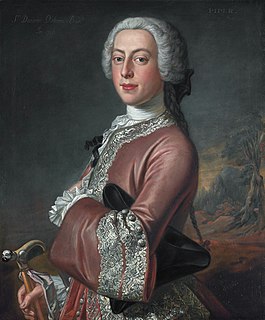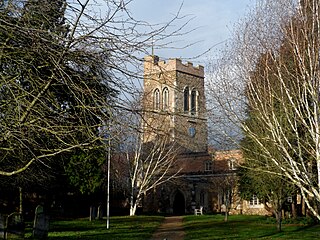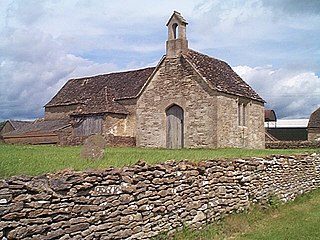
Biggleswade is a market town and civil parish in Central Bedfordshire in Bedfordshire, England. It lies on the River Ivel, 11 miles (18 km) south-east of Bedford. Its population was 16,551 in the 2011 United Kingdom census, and its estimated population in mid-2019 had increased to 21,700, its growth encouraged by good road and rail links to London. The King's Reach development, begun in 2010, will provide 2,000 new homes to the east of the town.

Ministry of Defence Chicksands or more simply MoD Chicksands is a UK Ministry of Defence station located 7.7 miles south east of Bedford, Bedfordshire and 11.6 miles north east of Luton, Bedfordshire. Now the location of the Defence Intelligence and Security Centre (DISC), it was previously named RAF Chicksands.

The present St Mary's Church is located in the centre of the small village of Clophill, between Bedford and Luton in the South Midlands of England. The new church, built in 1848, replaced the old church by order of the Church Commissioners in 1850. The old church building, formally The Church of St Mary The Virgin and known colloquially as Old St Mary's or The Old Parish Church, is at the edge of the village, and is estimated to be around 650 years old. It sits at the crest of the Greensand Ridge, offering views over the surrounding countryside. Its graveyard is a haven for wild flowers and wildlife. After the church moved to the village centre, incorporating various items from the old church building, the old building was converted for use as a mortuary chapel, but in the 1950s it fell into ruin.

Bedfordshire is an English ceremonial county which lies between approximately 25 miles and 55 miles north of central London.

Campton is a village in the Central Bedfordshire district of Bedfordshire, England. It is part of the civil parish of Campton and Chicksands with the nearby Chicksands. It is about 9 miles (14 km) south of Bedford, and is about 9 miles (14 km) north-west from Letchworth and sits on a tributary of the River Ivel. It is just to the west of Shefford. The 13th century Church of All Saints is in the centre of the village.

Mid Bedfordshire is a constituency represented in the House of Commons of the UK Parliament since 2005 by Nadine Dorries, of the Conservative Party. Apart from four early years, the constituency has returned a Conservative since its creation in 1918.

Shefford is a town and civil parish located in the Central Bedfordshire district of Bedfordshire, England. At the 2001 census it had a population of 4,928, and was estimated to have grown to 5,770 by 2007. The population at the 2011 Census had risen to 5,881.

Chicksands is a village in the Central Bedfordshire district of Bedfordshire, England, and part of the civil parish of Campton and Chicksands, whose population in 2007 was estimated to be 2,510. By the 2011 census the figure was accurately placed at being 1,699. The village is on the River Flit and close to its parish village of Campton and the town of Shefford.

Sir Danvers Osborn, 3rd Baronet, served briefly in 1753 as colonial governor of New York Province. During the Jacobite Uprising, he had raised and commanded troops in support of the king. He later served as a Member of Parliament from Bedfordshire (1747–1753). In 1750, he traveled to Nova Scotia and was part of the Nova Scotia Council. He had a history of melancholia, as it was then called, and committed suicide in New York shortly after taking office.

Clifton is a village and civil parish in the English county of Bedfordshire. The original hundred of Clifton is named after it.

Southill is a rural village and civil parish in the Central Bedfordshire district of the county of Bedfordshire, England; about 8 miles (13 km) south-east of the county town of Bedford.

Central Bedfordshire is a unitary authority area in the ceremonial county of Bedfordshire, England. It was created in 2009.

Shefford Town & Campton Football Club is an English football club based in the town of Shefford, Bedfordshire. The team plays its home matches at Shefford Sports Club on Hitchin Road in Shefford and at Campton Playing Fields, Rectory Road in Campton. The club is competing at the 10th tier of the English football league system in the Spartan South Midlands Football League Division One. The club also has a reserve side competing in the Premier Division,an U23s team competing in Division 3 and an A Team in Division 4 all in the Bedfordshire County Football League.

Bradbourne Priory was a priory in Bradbourne, Derbyshire, England.

Bremilham, also known as Cowage or Cowich, is a small settlement and former civil parish in Wiltshire, England. It is near the hamlet of Foxley in the parish of Norton. The nearest town is Malmesbury, about 2 miles (3.2 km) away to the north east.

Sir Stanley John Odell was a British businessman who was Chairman of the National Union of Conservative and Unionist Associations from 1989 to 1990, an organisation of the Conservative Party in the United Kingdom.

The Church of St Mary the Virgin is the Church of England parish church for Stotfold and nearby Fairfield in Bedfordshire. The church comes under the Diocese of St Albans and is Grade II* listed.




























